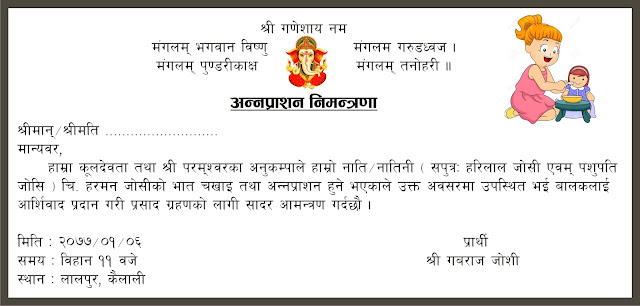Rice feeding ceremony Nepal, Annaprashan bidhi, Pasni ceremony of Nepali baby boy or girl.
Bhat chakhai, the Weaning Ceremony or the Rice Feeding Ceremony is also called bhaat chakhai celebration in Nepal. In which, a child is first fed rice by the family and other invited members from society. Although centuries old tradition, modern science has established the fact that child's digestive system is capable of processing solid food when they are approximately six months old which is why Pasni is held for when a baby turns six months old but it can vary between daughters and sons.
Nepal Rice Feeding Invitation Card | Weaning Ceremony in Nepal
 |
| Weaning ceremony in Nepal, Annaprashan Invitation Card Design |
Baby Annaprashan Card/Baby Annaprashan Invitation Card
About rice feeding process in Nepal, What is Weaning ceremony?
Annaprashan ceremony is held at five months for daughters, and six months for sons in a Nepal. An auspicious date and time is chosen by an astrologer, usually a Hindu, and all the closest relatives are invited to witness and to celebrate. The rice is the first and easily digestible solid food baby eats. This custom varies with the variation of religion, caste and also place. Like mangolians Gurung, Magar serve with kheer (rice pudding) which is rice cooked with milk and sugar similarly Brahmin, Kshatris also do same. Whereas myriads of dishes are prepared and served in Newar. The main rice dish is served in one giant (often woven) plate of leaves. The remaining dishes, typically 84, are served around the main dish.
Annaprashan wishes in Nepal/ Annaprashan Quotes/ Rice feeding Nepal
Nepali baby Pasni dress, Rice feeding dress for baby
Baby is dressed in saffron silk cloth (although modern families will often put a diaper (nappy) on, to minimize accidents.) The baby is held by baby’s mother while the entire family feed her or him the first taste of rice. It is the mother's right to feed the child first. This is because symbolically, after breastfeeding the child, she is asking her senpai to bless the child who is now entering the world of other regular food. Musicians playing traditional music can be invited to start the function at the given auspicious time. After the baby has eaten, she or he will undergo another extensive puja (worship ceremony) often led by a Five-year-old and accompanied by chanting from ancient scriptures.
Rice feeding ceremony in Nepal, Pasni Invitation card design Nepal, Pasni Baby
For the rest of the day, the baby is dressed in a special outfit, usually made of red velvet and embroidered with silver and golden thread. The child is offered with gifts, money by close relatives, and gold and silver ornaments by grandparents. These ornaments include heavy silver anklets (kalli) carved with dragon at both the ends to keep the bad omens away from baby. These ornaments can be handed on as heirlooms. In some newar community, it is also common for son to have right ear pierced on upperside with gold ornaments with different beads
Nepali Baby Pasni bidhi, Nepali rice feeding Bidhi, Annaprashan Dress for Baby
Pasni ceremonies have become extensively lavish these days, with large parties of not just close relatives, but also colleagues and friends being invited for the event. The guests, numbering in their hundreds, partake in a wedding-style banquet under tents, which are often catered by commercial catering agencies. They also bring gifts for the child, a new custom that has become more popular with the commercial rise of clothes, toys and other gift items targeted towards children.


No comments:
Post a Comment
Thanks